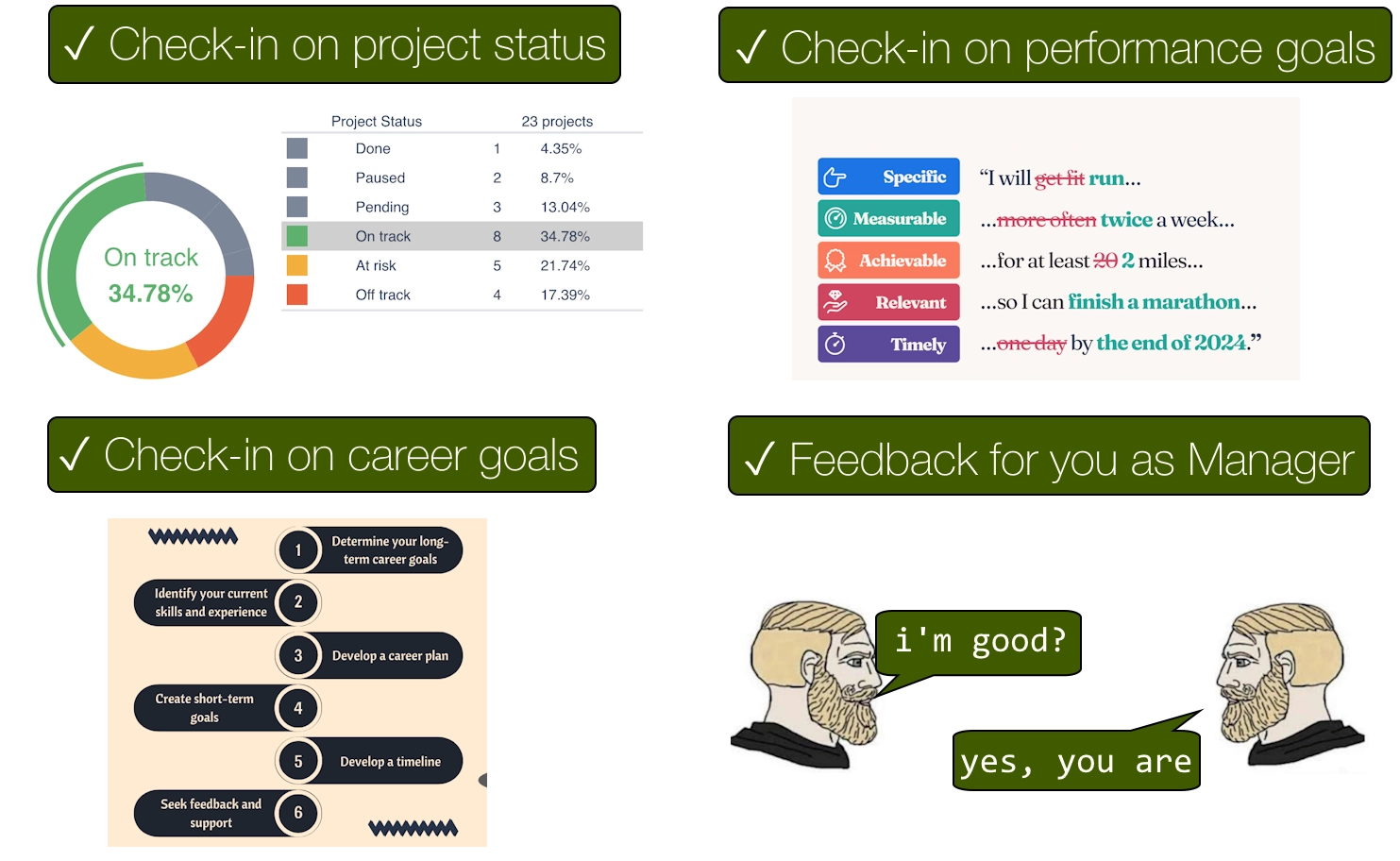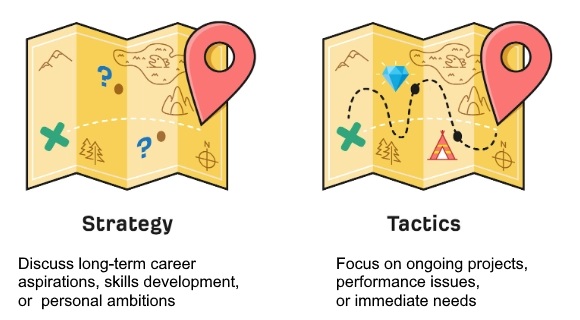10 Tips for Effective 1-2-1 Meetings

1:1 meetings are among the most effective tools in a manager’s toolkit. When done right, they foster better communication, build trust to align on goals, and address concerns. A successful 1-2-1 meeting might involve an employee sharing a challenge. Together, you brainstorm solutions. This leads to a clear action plan and increased motivation. However, running effective 1-2-1s isn't always straightforward. Common pitfalls include: a lack of preparation, one-sided talks, and focusing too much on urgent tasks at the expense of long-term growth.
Objectives for 1:1 meetings

- Learn about the status of deliverables, anything blocking the person;
- Work toward their career goals;
- Provide timely feedback, positive and negative;
- Let them provide feedback for you.
The 10 tips for effective 1:1 meetings are below:
1. Set a Consistent Cadence

The first step to mastering 1:1s is ensuring they are consistent. A regular meeting schedule demonstrates commitment and makes employees feel valued. Consider a frequency that suits your team. Ideally, once per week.
Tip:
Avoid canceling or rescheduling 1-2-1s unless necessary. When managers frequently cancel these meetings, it sends the message that they’re not a priority.
2. Prepare an Agenda in Advance
Preparation is key to a productive one-on-one meeting. Without a set agenda, talks can drift or become too casual. They may lose focus.
A simple agenda for 1-2-1 might include:

- ✓ Check-in on project status;
- ✓ Check-in on performance goals;
- ✓ Check-in on career goals;
- ✓ Feedback for you as Manager.
Tip:
Share the agenda at least 24 hours before the meeting, allowing both parties to prepare and reflect on discussion points.
Questions for 1:1 with a developer: Examples
General Well-being & Engagement
- How are you feeling about your work today?
- Is there anything about the work environment that affects your motivation?
- What’s the biggest thing worrying you right now?
Project-Specific Feedback
- What are your top priorities for this week? Any problems you expect to face?
- Last time we talked, you mentioned Project X was tough. How’s it going now?
- How happy are you with the result of the last feature you worked on? Anything you would do differently?
Tools & Resources
Are there any tools or software you wish you had to make your work easier?
Team & Company Dynamics
- Do you feel aligned with the company's direction? Is there anything you'd like to understand better?
- How is your collaboration with the team? Is there anything we can do to improve teamwork?
- How do you think your work fits with our company goals? Anything you’d improve?
Career Development & Goals
- What do you want to achieve in the next year, and how can I help you with that?
- When you think about the next three years, what do you see for yourself?
- Do you feel like you’re making progress on your career goals? Is there anything you need from me to help?
Manager Feedback
- Do you have any feedback for me?
- Is there anything I can do to help you before our next meeting?
3. Active Listening

Sometimes it's hard not to multitask during the meetings. But, during 1-2-1s, undivided attention is crucial. This builds trust and encourages open communication, which leads to more honest discussions. "I understand you're overwhelmed by the new project deadlines." Let’s discuss how we can adjust the workload." This demonstrates that you are paying attention and value their concerns.
Tip:
Close your laptop, put your phone away, and focus on the conversation. Make eye contact, ask follow-up questions, and repeat back key points to ensure clarity and understanding.
4. Balance Tactical and Strategic Discussions

Not all 1-2-1 meetings need to revolve around daily tasks or immediate projects.
Consider alternating between tactical and strategic conversations:
- Tactical meetings: Focus on ongoing projects, performance issues, or immediate needs.
- Strategic meetings: Discuss long-term career aspirations, skills development, or personal ambitions.
Tip:
Ask open-ended questions such as, "Where do you see your career in 2–3 years?" or "Are there any skills you’d like to develop?"
5. Constructive Feedback

A 1-2-1 meeting is the perfect opportunity for managers to give feedback privately. However, be mindful of how you frame feedback. Ensure it is constructive and actionable, offering specific examples and suggestions for improvement.
Key points for effective feedback:
- Don’t wait too long to bring up issues.
- General feedback can be confusing. Be specific and give clear examples.
- Focus on the solution, not just the problem.
Tip:
Incorporate positive feedback as well. Acknowledging wins and reinforcing good behaviors is just as important as addressing areas for improvement.
6. Two-Way Feedback

A successful 1-2-1 meeting isn't just about the manager giving feedback. It should be a two-way street. Encouraging your team members to provide you with feedback fosters a culture of openness and continuous improvement.
Ask questions like:
- "Is there anything I can do to support you better?"
- "What can I improve on as your manager?"
Tip:
Accept feedback with an open mind, even if it’s difficult to hear. This shows humility and a genuine interest in your growth as a leader.
7. Take Notes and Follow Up

Taking notes during the meeting helps you stay organized and provides a record of what was discussed. It also demonstrates to the employee that you take the conversation seriously. More importantly, always follow up on the action items discussed. Failure to do so can undermine the entire purpose of the meeting.
Tip:
After the meeting, send a quick summary of key points and agreed-upon actions to ensure alignment and accountability.
8. Make Room for Personal Connection

1-2-1 meetings are a great opportunity to connect with your team members personally. While keeping the conversation professional is essential, showing interest in their well-being or personal aspirations can strengthen your working relationship.
Simple questions to ask:
"How are things outside of work?"
"Is there anything I can do to help with work-life balance?"
Tip:
Be empathetic but respectful of boundaries. Not every employee will feel comfortable discussing their personal life, so read the room and adjust accordingly.
9. Use a Tool for Tracking and Organization

With multiple team members to manage, keeping track of each 1-2-1 meeting can be challenging. Using a tool or template to document these conversations can help ensure consistency and follow-through.
Popular tools for tracking 1-2-1s:
- Google Docs or Notion: For collaborative agenda-building and note-taking.
- Lattice, leapsome, or 15Five: For structured feedback and performance tracking.
- Calendar reminders: To keep meetings regular and avoid rescheduling.
Tip:
Customize your tracking system to suit your management style and team needs. What’s important is that there’s a record of the discussions, goals, and feedback over time.
10. End on a Positive Note

No matter how challenging a 1-2-1 might be, aim to end the meeting positively. This could be a word of appreciation, a compliment on recent work, or simply an acknowledgment of progress.
Tip:
Regularly celebrating small wins can boost morale and engagement.
Conclusion

Mastering 1-2-1 meetings is an ongoing process that requires thought, consistency, and a genuine commitment to your team's growth. By focusing on structured preparation, active listening, and two-way feedback, you’ll be well on your way to turning these meetings into productive, growth-oriented conversations. Remember, the ultimate goal of a 1-2-1 is not just to check a box but to foster a deeper, more meaningful connection with your team members.
Now, it’s time to put these hacks into practice and start transforming your 1-2-1s into invaluable leadership tools.
